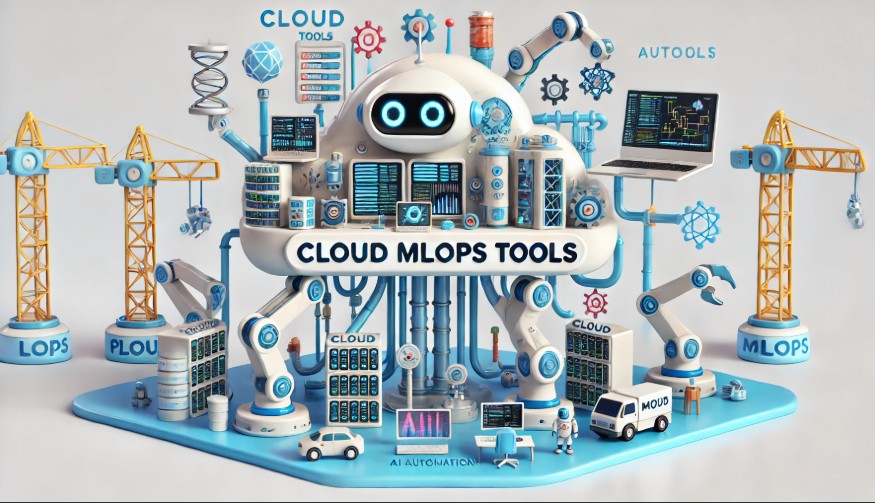Table of Contents
Introduction
Machine Learning Operations (MLOps) is a critical discipline for deploying and managing machine learning (ML) models at scale. With the increasing demand for AI-driven applications, businesses are turning to Cloud MLOps tools to streamline the lifecycle of ML models, from development to production. These tools help automate tasks, enhance collaboration, and ensure model reliability.
In this comprehensive guide, we’ll explore the best Cloud MLOps tools, their features, benefits, and real-world applications.
What Are Cloud MLOps Tools?
Understanding MLOps in the Cloud
Cloud MLOps tools integrate DevOps principles into the ML pipeline, enabling data scientists and engineers to:
- Automate model training and deployment.
- Monitor and manage ML models in production.
- Improve reproducibility and collaboration.
- Scale ML solutions efficiently across cloud infrastructure.
These tools leverage cloud computing power, reducing infrastructure management overhead while ensuring scalability and cost-efficiency.
Top Cloud MLOps Tools
1. Amazon SageMaker
Amazon SageMaker provides a complete suite of services for building, training, and deploying ML models at scale.
Key Features:
- AutoML for easy model training.
- Built-in Jupyter notebooks.
- Real-time and batch inference.
- Model monitoring and drift detection.
2. Google Vertex AI
Google’s Vertex AI is a unified MLOps platform that simplifies the end-to-end ML workflow.
Key Features:
- Unified AI pipeline for training and deploying models.
- Custom and AutoML capabilities.
- Model monitoring and metadata tracking.
- Seamless integration with BigQuery and TensorFlow.
3. Microsoft Azure Machine Learning
Azure ML offers robust MLOps capabilities, making it a popular choice among enterprises.
Key Features:
- Drag-and-drop ML designer.
- ML pipelines for automation.
- ML model monitoring and lineage tracking.
- Integrated security and compliance features.
4. Databricks MLOps
Databricks provides a collaborative workspace for ML teams, combining Apache Spark with MLOps best practices.
Key Features:
- Managed MLflow integration.
- Collaborative notebooks for data scientists.
- Automated tracking and version control.
- Scalable computing with Delta Lake.
5. Kubeflow
Kubeflow is an open-source Kubernetes-based platform for deploying ML workflows.
Key Features:
- Containerized ML model deployment.
- Scalable, cloud-agnostic architecture.
- TensorFlow Extended (TFX) integration.
- End-to-end pipeline management.
How to Choose the Right Cloud MLOps Tool
Factors to Consider:
- Scalability – Can the tool handle increasing data volumes?
- Ease of Use – Does it offer low-code or no-code options?
- Integration – Can it integrate with existing cloud and DevOps tools?
- Cost – Is the pricing model budget-friendly?
- Security & Compliance – Does it meet regulatory requirements?
Implementing Cloud MLOps: Step-by-Step Guide
Step 1: Define ML Workflow
- Identify business objectives.
- Define data sources and preprocessing steps.
Step 2: Select MLOps Tool
- Choose a tool based on scalability, cost, and ease of use.
Step 3: Develop and Train Models
- Use AutoML or custom scripts for training.
- Optimize hyperparameters and validate results.
Step 4: Deploy ML Models
- Choose real-time or batch inference.
- Utilize CI/CD pipelines for automation.
Step 5: Monitor and Maintain
- Set up drift detection.
- Continuously retrain models based on new data.
Cloud MLOps Tools in Action: Real-World Examples
Example 1: Automating Fraud Detection
A financial institution leverages Google Vertex AI to automate fraud detection in transactions, reducing false positives by 40%.
Example 2: AI-Powered Healthcare Diagnostics
A hospital uses Amazon SageMaker to train and deploy deep learning models for radiology imaging analysis.
Example 3: Personalized E-commerce Recommendations
An online retailer integrates Azure Machine Learning to build a recommendation system, increasing conversion rates by 30%.
FAQ Section
1. What are the benefits of using Cloud MLOps tools?
Cloud MLOps tools provide scalability, automation, cost-efficiency, and improved model monitoring.
2. Which Cloud MLOps tool is best for beginners?
Google Vertex AI and Amazon SageMaker offer user-friendly AutoML features, making them ideal for beginners.
3. Can Cloud MLOps tools be used for deep learning?
Yes, tools like Azure ML, SageMaker, and Databricks support deep learning models with GPU acceleration.
4. How do I monitor ML models in production?
Use built-in monitoring features in Cloud MLOps tools, such as drift detection, logging, and performance tracking.
5. What is the difference between MLOps and DevOps?
MLOps focuses on automating the ML lifecycle, whereas DevOps is centered on software development and deployment.
External Resources
- Amazon SageMaker Documentation
- Google Vertex AI Overview
- Microsoft Azure Machine Learning
- Kubeflow Official Site
- Databricks MLOps Guide

Conclusion
Cloud MLOps tools are transforming the way businesses deploy, monitor, and scale machine learning models. By leveraging platforms like Amazon SageMaker, Google Vertex AI, Azure ML, Databricks, and Kubeflow, organizations can streamline their AI workflows and achieve higher operational efficiency.
Whether you’re a beginner or an enterprise looking to optimize ML operations, choosing the right Cloud MLOps tool will help you unlock AI’s full potential.
Ready to integrate MLOps into your workflow? Explore the tools mentioned and start optimizing your AI processes today! Thank you for reading the DevopsRoles page!
